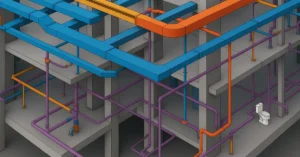Staying Ahead with AI for Architects: Embracing the Future

In the rapidly evolving field of architecture, staying ahead of technological advancements is not just an option; it’s a necessity. Artificial Intelligence (AI) has emerged as a transformative force, reshaping the way architects design, plan, and interact with spaces. This comprehensive guide explores how architects can harness AI to remain at the forefront of innovation, enhancing creativity, efficiency, and sustainability in their projects.
Understanding AI’s Role in Architecture
AI in architecture goes beyond mere automation. It offers intelligent solutions that can predict, adapt, and respond to various design and environmental challenges. From generative design algorithms that can produce countless design variations to AI-powered analysis tools that optimize buildings for energy efficiency, AI is setting a new standard for what is possible in architecture.
Generative Design: A Game-Changer
One of the most significant contributions of AI to architecture is in generative design. Generative design algorithms use input parameters such as site conditions, building requirements, and material constraints to generate numerous design options. This approach allows architects to explore a much broader range of possibilities than traditional methods would permit. By leveraging generative design, architects can discover innovative solutions that might otherwise remain undiscovered.
Optimizing Sustainability with AI
Sustainability is a critical consideration in modern architecture, and AI can play a pivotal role in optimizing designs for environmental performance. AI-driven analysis tools can simulate various scenarios and provide architects with data-driven insights to make informed decisions about energy use, carbon footprint, and material efficiency. By harnessing the power of AI, architects can create buildings that not only meet the needs of their occupants but also minimize their environmental impact.
Enhancing Visualization and Presentation
In addition to aiding in the design process, AI can also enhance the way architects communicate their ideas to clients and stakeholders. AI-enhanced rendering and virtual reality (VR) tools allow architects to create immersive presentations that provide a realistic sense of what the finished project will look like. By incorporating these technologies into their workflow, architects can improve client engagement and ensure that everyone involved in the project has a clear understanding of the design intent.
Streamlining Project Management with AI
Project management is another area where AI can make a significant difference for architects. AI algorithms can analyze project data to predict potential delays, optimize resource allocation, and automate routine tasks. By leveraging AI for project management, architects can streamline their workflows, reduce administrative overhead, and free up time to focus on the creative aspects of their projects.
Continuous Learning and Adaptation
As AI continues to evolve, it’s essential for architects to stay informed about the latest tools and methodologies. Engaging with online courses, workshops, and professional networks dedicated to AI in architecture can help architects stay ahead of the curve and ensure that they’re always using the most up-to-date tools and techniques. By committing to lifelong learning, architects can continue to innovate and push the boundaries of what’s possible in architecture.
Ethical Considerations and Client Transparency
As with any emerging technology, AI raises important ethical considerations that architects must navigate carefully. Issues such as data privacy, algorithmic bias, and the potential impact of AI on employment within the industry require thoughtful attention. It’s essential for architects to approach the use of AI ethically and transparently, maintaining open lines of communication with clients about how AI is being used in their projects and ensuring that their practices align with ethical standards.
Conclusion: Embracing the Future of Architecture with AI
In conclusion, AI has the potential to revolutionize the field of architecture, offering architects powerful tools to enhance creativity, efficiency, and sustainability in their projects. By embracing AI and staying informed about the latest developments in the field, architects can not only stay ahead of the curve but also shape the future of architecture in the digital age. With the right approach, AI can be a valuable ally for architects, helping them to unlock new possibilities and create buildings that are more beautiful, functional, and environmentally friendly than ever before.
If you’re interested in learning more about architecture firms in Europe, check out this comprehensive list of the top 50 firms compiled by Archgyan. From innovative startups to long-established industry leaders, this list has it all. Take a look and discover some of the most inspiring and influential architecture firms in Europe today.
If you’re interested in architecture and want to learn more about this amazing field, subscribe to our podcast on youtube
For more SketchUp tutorials, head to https://www.sketchupguru.com










